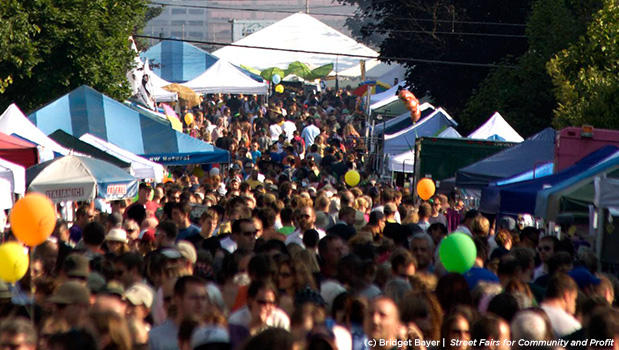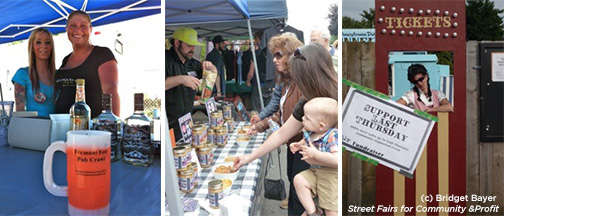Announcing the 2025 GM on Main Street Grant Recipients
Meet the recipients of the 2025 GM on Main Street grants!

This is the second article in a three-part series on street fairs. Read the first article, Building Community Through Street Fairs: Identifying Community Assets.
Street Fairs are fun! Fundraising is not. Unless an individual or local business would like to underwrite the full cost of your Fair, consider the following eight tested fundraising programs. Rally a couple dedicated volunteers to think through your options carefully and honestly calculate how much time your volunteer crew is willing to spend.
1. If you have a lot of businesses in your area, create different kinds of promotional activities.
Offer sponsor exposure to businesses making in-kind donations of food, space, copies, equipment for your Street Fair. Many businesses want promotional opportunities and need to get their name out to the public. Though they may not be able to contribute money, in-kind donations will reduce overall expenses.
Start a “passport program” with local restaurants and retailers to raise money and provide advance promotions your event. To raise money, passports can be sold to end-users. Participants can be charged or paid advertisements can be included.
Request restaurants, breweries or bars to host “support nights” where a percentage of sales goes to your event. This requires interconnected marketing efforts.
Contests or raffles create fun and stimulate trust when winners take home prizes. Be aware that these activities are often a lot of work. Try partnering with local non-profits to promote and sell tickets. Make dynamic, eye-catching posters to engage your audience. Follow though on promises, both to the winner and participants.

Pub crawls bring customers into businesses; Free tastes draw fair attendees to sponsors; Costumed characters draw fair-goers to fundraisers
2. If you have several large anchor businesses create a sponsorship program that describes their return on investment (ROI).
Businesses want promotional opportunities to state how their name or logo will be represented and where. They need to know statistics on attendance, media exposure, other participants and relevant expense information.
Find out what is important to potential sponsors and tailor benefits to appeal to their promotional interests. Some businesses really want to support community events, some want access to news media, others want to build relationships. Almost all sponsors want exposure to fair crowds*. Show them how they benefit from their investment.
List sponsor benefits in levels. Levels can be creatively labeled based on your area or simple, like: Win, Place and Show, or Gold, Silver and Bronze. Sponsor outreach messages should be professional and consistent with your brand, yet remain lively and informal.
Don’t be discouraged by a “No.” Large corporations, and even small businesses, don’t give away money by nature. Find out what is important to potential sponsors. Try building a relationship with someone first because “who you know” works especially well when making sponsorship requests. Invite potential sponsors to other activities throughout the year. You may hear that it’s not the right time to ask, so make sure to find out the best time for requests the following year.
FULL SENSORY SPONSORSHIP OPPORTUNITIES*
Develop a business sponsorship program by offering promotional opportunities based on the five senses.
SEE: Advertisements, posters and flyers are the obvious places for sponsors to get promoted. Others include; banners at activity areas or entrances, signs at stages, in programs and on t-shirts.
HEAR: An MC announces sponsors from the stage or uses prerecorded announcements. Make announcements funny. Street performers can thank sponsors or be posted on tip signs.
TASTE: Sponsors can provide samples of snacks, coupons or water. Restaurants, carts and cooking competitions connect to fair-goers with free tastes.
SMELL: Aroma is half the pleasure of tasting something. Allow sponsors to cook, give samples and provide food demonstrations that entice audiences their way. Smells are always free.
TOUCH: Petting zoos or critter displays are a popular family activity, especially if the sponsor’s target market is kids. Sponsors provide water, feed, rides or pictures with animals.
*Based on Sylvia Allen, http://allenconsulting.com/services/corporate-sponsorship-salesand-training/
3. If you have a strong web presence, try crowd-funding online.
Does your website work for you? Do you have a high Klout score? A high number represents great influence. If you have dedicated online members and volunteers, online crowd-funding may work to make your event more profitable.
Use online crowd-funding tools to raise money to pay for entertainers, buy supplies or equipment. It’s important to fully articulate the what, and why, of your crowd-funding requests. Online resources are almost endless and will likely change even in the short time before this article is published. Check www.crowdfunding-websitereviews.com for the latest peer-reviewed choices to research the right one for your organization.
4. If you have a well-read community newspaper, cooperative advertising works well.
Your first step, if you haven’t already, is to define your target market. It’s important to narrow your focus because advertising is one of your biggest expenses. Write down who your customers are, or who shops in your area. Who do you want to know about your businesses? This is your target market.
Only consider media outlets that reach your target markets. Ask them to donate space as a sponsor or to provide steep discounts on co-op ads then add a small premium charge. If you pick exclusive “media partners”, make sure their organization fully buys-in to the promotion and will support your event. Some newspapers or broadcasting companies will “snatch and sit” on promotions, keeping them out of the hands of their competitors.

People want interesting and unique items that can’t be found in a department store or mall; Advertise event information free with co-op advertising in local newspapers
5. If you have many active volunteers, sell promotional items before and during the event.
Merchandise and memorabilia like T-shirts, mugs, photos and food can be hidden profit centers. Items that can be printed on, like T-shirts, hats, bags and wristbands not only generates cash, it also provides businesses places to advertise, another profit center. Find good deals and buy in bulk.
Choose the kind of products your target market will want. Do not put dates on T-shirts or items so inventory can be saved for future years. If not your first street fair, review previous year’s sales to determine popular items.
Ask for donations or discounts from suppliers. Ask them to be a sponsor by providing items free, or heavily discounted, in exchange for business promotions.
Be creative, offer a promotional item that people want. Don’t just print “Street Fair” on a T-shirt - punch it up. In the Montavilla neighborhood in Portland, Oregon, organizers created “Monta Villains” T-shirts that people loved. Add major sponsors to promo materials.
6. If you have a large area, include street vendors at your event.
Vendors’ fees can cover as much as one-third of a total fair budget. Determine the type and number of street vendors before starting your outreach. Measure your space accurately, accounting for trees, driveways or overhead obstructions.
The mix of vendors likely depends on the merchants already in your area. Street vendors can be the businesses on Main Street or in your commercial center. Encourage them to participate on fair day.
It’s critical to have food vendors, retail goods, arts and craft items. Women in the U.S. account for about 75% of all spending. Make sure to find vendors that offer items for female shoppers.
Attendance will dictate how many vendors are right for your fair. Be conservative at first, starting with a small area.
7. If you have fenced areas, or can enclose areas, use them for activities and change for entry.
Street fairs by nature are free, since they are usually staged in the public right of way. However, properties adjacent to the Fair can entice people to activities that can charge a fee. An obvious choice is a beer and wine garden. The trick to make a lot of money is to get beverages donated.
Post volunteer greeters with donation aprons at entrances to kids areas, petting zoos, historical or special display areas. Sell tickets for rides or games too. Races, walks and runs that happen on fair day usually have a separate fee. Watch expenses carefully with larger activities!
8. If you have government support, take advantage of grant opportunities.
Apply for economic development or arts grants from the local Chamber of Commerce, or City or State agencies. Make sure your goals match their needs and values. Don’t change the focus of your fair just to get a grant.
It’s easier to apply for grants after the second or third fair. Make notes of goals met and achievements during the planning process. Record attendee numbers, participating partners, stakeholders and sponsors.
Offer your street fair as a place for partners to host fundraisers. Their organization may be able to solicit grant funding that can pay for organizational or administrative support, paying for an experienced manager, fundraiser or volunteer coordinator.
This is the second article in a three-part series on street fairs. Up next: Making Your Street Fair Profitable - Planning Outline.
Over the past two decades, Bridget Bayer has lived and breathed community development—from building and running her own small businesses, to working with more than 20 business associations in the Portland metro area—to managing and training over 1,500 volunteers. Her company, BAM, (Business Association Management) is a consulting firm that helps build community through events, raise funds and enhance the visibility of main streets and community groups.
One of the founders and hands-on organizer of the wildly successful Mississippi Street Fair, Bayer is bringing her considerable community-building skills and experience to a wider audience with a new book, Street Fairs for Community and Profit. The guidebook focuses on how to strengthen a community and profit by it through effective planning and executing sensational street fairs.